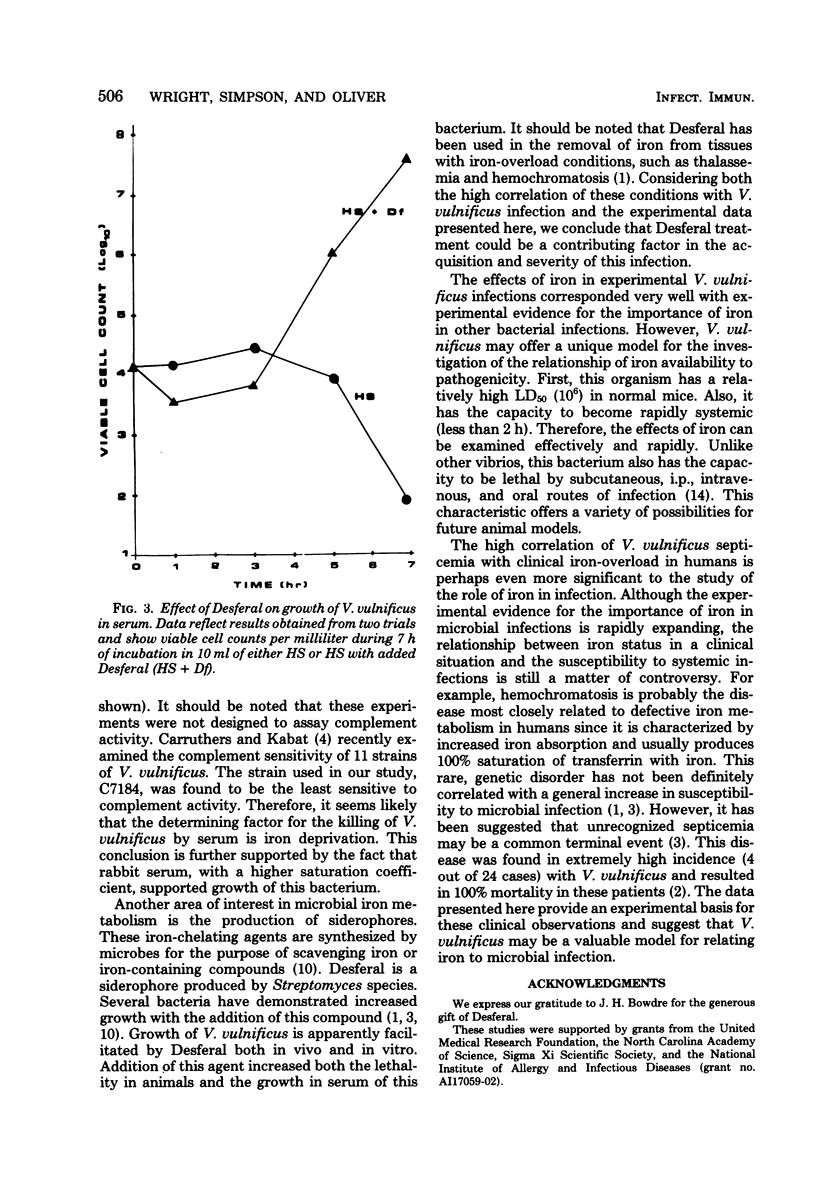Abstract
Infections with Vibrio vulnificus resulting in septicemia and high mortality have been correlated with pre-existing liver disease and hemochromatosis. As these conditions are associated with impaired iron metabolism and as iron availability in the host has been implicated in the pathogenicity of a number of bacterial infections, the role of iron as a possible factor in the pathogenesis of V. vulnificus was examined. Injection of mice with iron resulted in a lowering of the 50% lethal dose from 10(6) to 1.1 cells and in a reduction in the time of death postinfection. Elevated serum iron levels were also produced by damaging livers with injections of CCl4. The inoculum size required to kill these mice was directly correlated with serum iron levels. Since the portal of infection of this organism may be ingestion of contaminated seafood, the effects of iron upon orally induced infection were also studied. The effects of adding iron, transferrin, or Desferal (an iron chelate) upon the growth of V. vulnificus in human and rabbit sera were also examined. Iron appeared to be the limiting factor in the ability of this organism to survive or grow in mammalian sera. These results, both in vitro and in vivo, provided strong evidence that iron may play a major role in the pathogenesis of V. vulnificus.
Full text
PDF




Selected References
These references are in PubMed. This may not be the complete list of references from this article.
- Blake P. A., Merson M. H., Weaver R. E., Hollis D. G., Heublein P. C. Disease caused by a marine Vibrio. Clinical characteristics and epidemiology. N Engl J Med. 1979 Jan 4;300(1):1–5. doi: 10.1056/NEJM197901043000101. [DOI] [PubMed] [Google Scholar]
- Carruthers M. M., Kabat W. J. Vibrio vulnificus (lactose-positive vibrio) and Vibrio parahaemolyticus differ in their susceptibilities to human serum. Infect Immun. 1981 May;32(2):964–966. doi: 10.1128/iai.32.2.964-966.1981. [DOI] [PMC free article] [PubMed] [Google Scholar]
- Díaz Gómez M. I., de Castro C. R., D'Acosta N., de Fenos O. M., de Ferreyra E. C., Castro J. A. Species differences in carbon tetrachloride-induced hepatotoxicity: the role of CCl4 activation and of lipid peroxidation. Toxicol Appl Pharmacol. 1975 Oct;34(1):102–114. doi: 10.1016/0041-008x(75)90179-9. [DOI] [PubMed] [Google Scholar]
- Fletcher J. The effect of iron and transferrin on the killing of Escherichia coli in fresh serum. Immunology. 1971 Apr;20(4):493–500. [PMC free article] [PubMed] [Google Scholar]
- Holbein B. E. Iron-controlled infection with Neisseria meningitidis in mice. Infect Immun. 1980 Sep;29(3):886–891. doi: 10.1128/iai.29.3.886-891.1980. [DOI] [PMC free article] [PubMed] [Google Scholar]
- Holbein B. E., Jericho K. W., Likes G. C. Neisseria meningitidis infection in mice: influence of iron, variations in virulence among strains, and pathology. Infect Immun. 1979 May;24(2):545–551. doi: 10.1128/iai.24.2.545-551.1979. [DOI] [PMC free article] [PubMed] [Google Scholar]
- Hollis D. G., Weaver R. E., Baker C. N., Thornsberry C. Halophilic Vibrio species isolated from blood cultures. J Clin Microbiol. 1976 Apr;3(4):425–431. doi: 10.1128/jcm.3.4.425-431.1976. [DOI] [PMC free article] [PubMed] [Google Scholar]
- Kochan I., Golden C. A., Bukovic J. A. Mechanism of tuberculostasis in mammalian serum. II. Induction of serum tuberculostasis in guinea pigs. J Bacteriol. 1969 Oct;100(1):64–70. doi: 10.1128/jb.100.1.64-70.1969. [DOI] [PMC free article] [PubMed] [Google Scholar]
- Kochan I., Wasynczuk J., McCabe M. A. Effects of injected iron and siderophores on infections in normal and immune mice. Infect Immun. 1978 Nov;22(2):560–567. doi: 10.1128/iai.22.2.560-567.1978. [DOI] [PMC free article] [PubMed] [Google Scholar]
- Oliver J. D., Colwell R. R. Extractable lipids of gram-negative marine bacteria: phospholipid composition. J Bacteriol. 1973 Jun;114(3):897–908. doi: 10.1128/jb.114.3.897-908.1973. [DOI] [PMC free article] [PubMed] [Google Scholar]
- Poole M. D., Oliver J. D. Experimental pathogenicity and mortality in ligated ileal loop studies of the newly reported halophilic lactose-positive Vibrio sp. Infect Immun. 1978 Apr;20(1):126–129. doi: 10.1128/iai.20.1.126-129.1978. [DOI] [PMC free article] [PubMed] [Google Scholar]
- REISSMAN K. R., BOLEY J., CHRISTIANSON J. F., DELP M. H. The serum iron in experimental hepatocellular necrosis. J Lab Clin Med. 1954 Apr;43(4):572–582. [PubMed] [Google Scholar]
- Schade A. L., Caroline L. An Iron-binding Component in Human Blood Plasma. Science. 1946 Oct 11;104(2702):340–341. doi: 10.1126/science.104.2702.340. [DOI] [PubMed] [Google Scholar]
- Sword C. P. Mechanisms of pathogenesis in Listeria monocytogenes infection. I. Influence of iron. J Bacteriol. 1966 Sep;92(3):536–542. doi: 10.1128/jb.92.3.536-542.1966. [DOI] [PMC free article] [PubMed] [Google Scholar]
- Weinberg E. D. Iron and infection. Microbiol Rev. 1978 Mar;42(1):45–66. doi: 10.1128/mr.42.1.45-66.1978. [DOI] [PMC free article] [PubMed] [Google Scholar]
- Weinberg E. D. Iron and susceptibility to infectious disease. Science. 1974 May 31;184(4140):952–956. doi: 10.1126/science.184.4140.952. [DOI] [PubMed] [Google Scholar]


